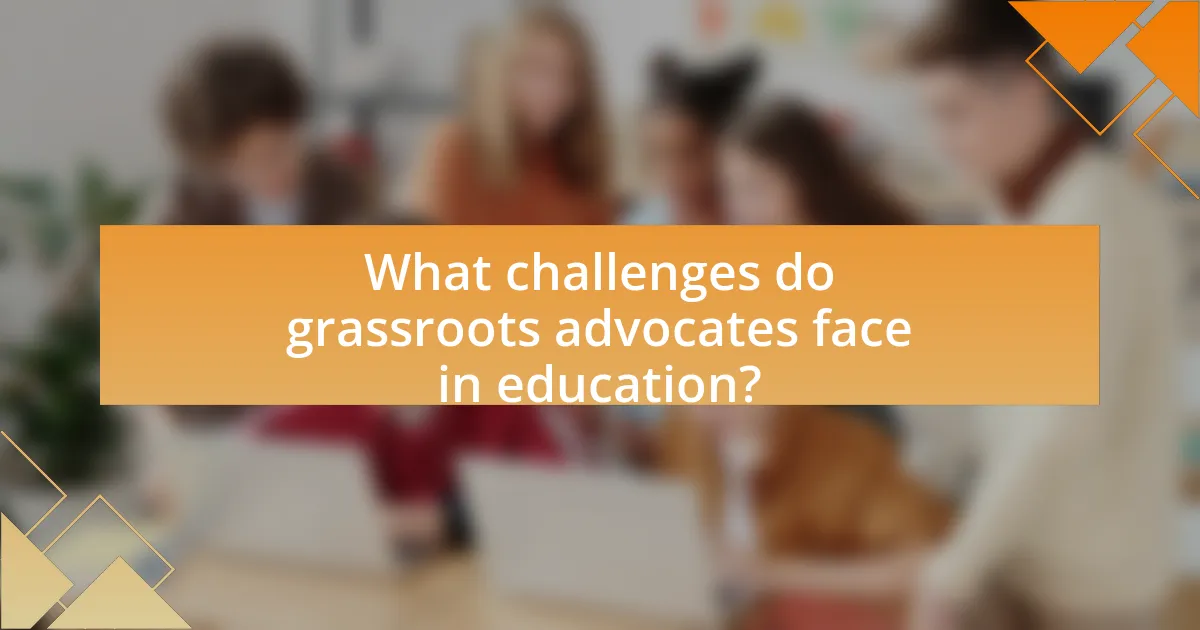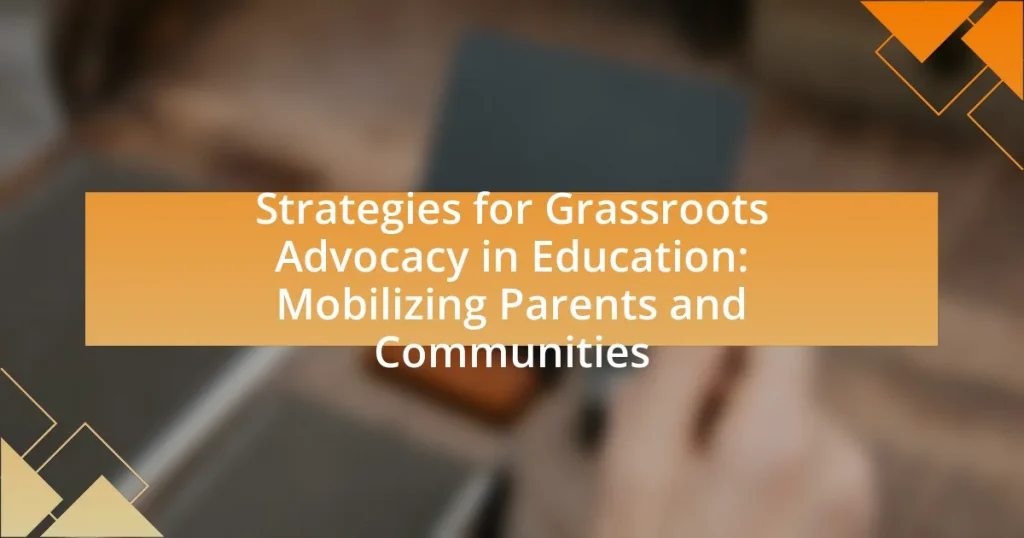The article focuses on strategies for grassroots advocacy in education, emphasizing the importance of mobilizing parents and communities to influence educational policies and practices. Key strategies discussed include building coalitions, engaging stakeholders, utilizing social media, and organizing community events. It highlights the critical role parents play in advocacy efforts, the impact of grassroots movements on educational reforms, and best practices for effective communication and collaboration. Additionally, the article addresses challenges faced by advocates and provides practical tips for enhancing grassroots efforts, ultimately underscoring the significance of community involvement in driving meaningful change in education.

What are the key strategies for grassroots advocacy in education?
Key strategies for grassroots advocacy in education include building coalitions, engaging stakeholders, utilizing social media, and organizing community events. Building coalitions allows diverse groups to unite for a common cause, enhancing influence and reach. Engaging stakeholders, such as parents, teachers, and local leaders, fosters a sense of ownership and commitment to educational issues. Utilizing social media effectively amplifies messages and mobilizes support quickly, as evidenced by campaigns that have successfully raised awareness and driven action. Organizing community events creates opportunities for dialogue and collaboration, strengthening community ties and advocacy efforts. These strategies collectively empower communities to advocate for educational improvements and reforms.
How can parents effectively mobilize their communities for educational change?
Parents can effectively mobilize their communities for educational change by organizing grassroots campaigns that engage local stakeholders. These campaigns can include forming parent-teacher associations, hosting community forums, and collaborating with local organizations to raise awareness about educational issues. Research indicates that when parents actively participate in advocacy efforts, such as the study by the National Parent Teacher Association, they can significantly influence policy changes and resource allocation in schools. By leveraging their collective voice and fostering partnerships, parents can create a strong network that drives meaningful educational reform.
What roles do parents play in grassroots advocacy efforts?
Parents play a crucial role in grassroots advocacy efforts by serving as primary advocates for their children’s educational needs and influencing policy changes. They mobilize their communities, organize events, and participate in campaigns to raise awareness about educational issues. For instance, research from the National Parent Teacher Association highlights that engaged parents can significantly impact school funding decisions and educational reforms. Their firsthand experiences and insights provide valuable perspectives that can shape advocacy strategies and drive collective action.
How can parents identify and engage with community stakeholders?
Parents can identify and engage with community stakeholders by actively participating in local meetings, joining parent-teacher associations, and utilizing social media platforms to connect with other parents and community members. Engaging in local school board meetings allows parents to meet educators, administrators, and other stakeholders directly involved in the education system. Research indicates that parents who are involved in school governance are more likely to influence educational policies and practices, thereby enhancing their children’s educational experiences. Additionally, leveraging social media can help parents share information, organize events, and mobilize support for educational initiatives, fostering a stronger community network.
Why is grassroots advocacy important in the education sector?
Grassroots advocacy is important in the education sector because it empowers parents and communities to influence educational policies and practices directly. This form of advocacy fosters local engagement, ensuring that the voices of those most affected by educational decisions are heard. Research indicates that when parents and community members actively participate in advocacy efforts, schools experience improved student outcomes, increased funding, and enhanced accountability. For example, a study by the National Education Association found that schools with strong parent involvement see a 20% increase in student achievement. Thus, grassroots advocacy serves as a critical mechanism for driving meaningful change in education.
What impact does grassroots advocacy have on educational policies?
Grassroots advocacy significantly influences educational policies by mobilizing community members to voice their needs and concerns, thereby shaping decision-making processes. This form of advocacy often leads to increased awareness among policymakers about local educational issues, resulting in policy changes that reflect the community’s priorities. For instance, research by the National Education Association indicates that grassroots movements have successfully advocated for increased funding and resources in underfunded schools, demonstrating the tangible impact of community engagement on educational policy outcomes.
How does grassroots advocacy empower marginalized communities in education?
Grassroots advocacy empowers marginalized communities in education by enabling them to actively participate in decision-making processes that affect their schools and educational policies. This form of advocacy fosters a sense of agency among community members, allowing them to voice their concerns, share their experiences, and influence local educational priorities. For instance, studies have shown that when parents and community members engage in advocacy efforts, such as organizing campaigns or participating in school board meetings, they can lead to significant changes in funding allocations and curriculum development that better reflect their community’s needs. Additionally, grassroots movements often build coalitions that amplify their voices, resulting in increased visibility and support for marginalized groups, which can lead to more equitable educational opportunities.

What are the best practices for mobilizing parents in grassroots advocacy?
The best practices for mobilizing parents in grassroots advocacy include building strong relationships, providing clear information, and creating opportunities for engagement. Establishing trust through consistent communication fosters a sense of community among parents, which is essential for effective advocacy. Providing clear, accessible information about issues and the advocacy process empowers parents to understand their role and the impact of their involvement. Additionally, organizing events, workshops, and meetings allows parents to engage actively, share their experiences, and collaborate on advocacy efforts. Research shows that when parents are actively involved, such as through initiatives like the National PTA’s “Family Engagement in Education” program, student outcomes improve, highlighting the importance of parent mobilization in grassroots advocacy.
How can effective communication enhance grassroots advocacy efforts?
Effective communication enhances grassroots advocacy efforts by fostering clear messaging and building strong relationships among stakeholders. When advocates communicate effectively, they can articulate their goals, mobilize support, and engage community members, which is crucial for driving change. Research shows that campaigns with coherent messaging are 50% more likely to achieve their objectives, as they resonate better with the audience and encourage participation. Additionally, effective communication helps in disseminating information quickly, allowing grassroots movements to respond to challenges and opportunities in real-time, thereby increasing their impact and reach within the community.
What tools and platforms can parents use for effective communication?
Parents can use various tools and platforms for effective communication, including messaging apps, social media, and dedicated educational platforms. Messaging apps like WhatsApp and Telegram allow for instant communication and group chats, facilitating quick updates and discussions among parents. Social media platforms such as Facebook and Twitter enable parents to share information, organize events, and engage with the school community. Additionally, educational platforms like ClassDojo and Remind provide structured communication channels between parents and teachers, allowing for announcements, reminders, and direct messaging. These tools enhance collaboration and ensure that parents stay informed and connected within the educational environment.
How can storytelling be utilized to inspire community involvement?
Storytelling can inspire community involvement by creating emotional connections and fostering a shared sense of purpose among community members. When narratives highlight local challenges and successes, they resonate with individuals, motivating them to engage in collective action. For instance, research by the Stanford Social Innovation Review indicates that stories can significantly enhance empathy and understanding, leading to increased participation in community initiatives. By illustrating real-life experiences and outcomes, storytelling effectively mobilizes parents and communities to advocate for educational improvements and social change.
What strategies can be employed to build a strong advocacy network?
To build a strong advocacy network, organizations should focus on establishing clear communication channels, fostering relationships, and leveraging community resources. Clear communication ensures that all members understand the goals and objectives of the advocacy efforts, which can be achieved through regular meetings, newsletters, and social media updates. Fostering relationships involves engaging with key stakeholders, including parents, educators, and community leaders, to create a sense of shared purpose and collaboration. Leveraging community resources, such as local organizations and businesses, can provide additional support and amplify the advocacy message. Research indicates that networks with strong communication and collaborative relationships are more effective in achieving their advocacy goals, as evidenced by successful grassroots movements in education reform.
How can parents collaborate with local organizations and schools?
Parents can collaborate with local organizations and schools by actively participating in school boards, volunteering for events, and engaging in community programs. This involvement fosters communication between parents and educators, ensuring that parents’ perspectives are considered in decision-making processes. Research indicates that parental engagement in schools leads to improved student outcomes, as highlighted in the study “The Impact of Family Engagement on Student Achievement” by the Harvard Family Research Project, which found that students whose parents are involved in their education tend to have higher grades and better attendance.
What are the benefits of forming coalitions for advocacy?
Forming coalitions for advocacy enhances collective power and effectiveness in influencing policy changes. By uniting diverse stakeholders, such as parents, educators, and community organizations, coalitions can amplify their voices, share resources, and leverage a broader range of expertise. Research indicates that coalitions can lead to more comprehensive strategies, as seen in the “Coalition for Community Schools” initiative, which demonstrated improved educational outcomes through collaborative efforts among various community entities. This collaborative approach not only increases visibility but also fosters a sense of shared responsibility, ultimately driving more impactful advocacy efforts.

What challenges do grassroots advocates face in education?
Grassroots advocates in education face significant challenges, including limited funding, bureaucratic resistance, and lack of access to decision-making processes. Limited funding restricts their ability to implement programs and outreach efforts effectively, as many grassroots organizations operate on tight budgets and rely on donations or small grants. Bureaucratic resistance often manifests in the form of policies that hinder grassroots initiatives, making it difficult for advocates to influence educational reforms. Additionally, grassroots advocates frequently encounter barriers to accessing key decision-makers, which limits their ability to advocate for necessary changes in educational policy and practice. These challenges collectively impede the effectiveness of grassroots advocacy efforts in mobilizing parents and communities for educational improvement.
How can advocates overcome resistance from educational institutions?
Advocates can overcome resistance from educational institutions by building strong relationships and demonstrating the benefits of proposed changes. Establishing trust through consistent communication and collaboration with school administrators and teachers fosters a supportive environment. For instance, presenting data that shows improved student outcomes from similar initiatives can effectively counter objections. Research indicates that schools that engage with community stakeholders experience higher levels of support and successful implementation of programs (Baker, 2018, “Community Engagement in Education,” Journal of Educational Research). By aligning advocacy goals with the institution’s mission and values, advocates can create a compelling case that addresses concerns and encourages buy-in.
What strategies can be used to address skepticism from school officials?
To address skepticism from school officials, building strong relationships through transparent communication is essential. Engaging school officials in open dialogues allows for the sharing of concerns and insights, fostering trust. Presenting data-driven evidence, such as successful case studies from similar initiatives, can further alleviate doubts. For instance, research from the National Education Association indicates that collaborative efforts between parents and schools lead to improved student outcomes, which can serve as a compelling argument for school officials. Additionally, involving school officials in the planning process can create a sense of ownership and investment in the initiative, reducing skepticism.
How can advocates maintain momentum in the face of setbacks?
Advocates can maintain momentum in the face of setbacks by fostering resilience through community engagement and adaptive strategies. Engaging the community creates a support network that reinforces commitment and motivation, as seen in successful grassroots movements where collective action leads to sustained advocacy efforts. Additionally, adapting strategies based on feedback and changing circumstances allows advocates to remain relevant and effective, as evidenced by initiatives that pivoted their approaches in response to challenges, ultimately leading to successful outcomes.
What legal and policy considerations should grassroots advocates be aware of?
Grassroots advocates should be aware of legal considerations such as compliance with local, state, and federal laws governing advocacy, lobbying, and campaign finance. These laws dictate how organizations can engage in political activities, including restrictions on funding sources and reporting requirements. For instance, the Internal Revenue Service (IRS) regulates the political activities of 501(c)(3) organizations, limiting their lobbying efforts to ensure they maintain their tax-exempt status. Additionally, advocates must understand policies related to education, such as the Every Student Succeeds Act (ESSA), which outlines the roles of parents and communities in shaping educational policies. Awareness of these legal frameworks is crucial for effective advocacy and to avoid potential legal repercussions.
How can advocates navigate local education laws and regulations?
Advocates can navigate local education laws and regulations by thoroughly researching the specific statutes and policies that govern their area. This involves accessing state and local education department websites, reviewing legislative documents, and understanding the framework of local school boards. For instance, the National Association of State Boards of Education provides resources that outline state-specific education laws, which can help advocates identify key regulations affecting their advocacy efforts. Additionally, attending school board meetings and engaging with local education officials can provide insights into the practical application of these laws, enabling advocates to effectively align their strategies with existing regulations.
What resources are available to help advocates understand their rights?
Advocates can access various resources to understand their rights, including legal aid organizations, advocacy groups, and government websites. Legal aid organizations provide free or low-cost legal assistance and information on rights related to education and advocacy. Advocacy groups, such as the American Civil Liberties Union (ACLU) and the National Education Association (NEA), offer resources, guides, and training on rights and advocacy strategies. Additionally, government websites, such as the U.S. Department of Education, provide official information on educational rights and policies, ensuring advocates have access to accurate and relevant legal information.
What practical tips can enhance grassroots advocacy efforts in education?
To enhance grassroots advocacy efforts in education, organizations should focus on building strong community coalitions. These coalitions can unite parents, educators, and local stakeholders to amplify their voices and influence policy decisions. Research indicates that collaborative efforts, such as the one documented in the “Community Schools Initiative” by the Coalition for Community Schools, demonstrate that partnerships can lead to improved educational outcomes and increased community engagement. Additionally, leveraging social media platforms for outreach and awareness can effectively mobilize support and disseminate information quickly, as evidenced by campaigns like #RedForEd, which successfully rallied educators and advocates nationwide.
How can parents effectively organize community meetings for advocacy?
Parents can effectively organize community meetings for advocacy by establishing clear objectives, engaging stakeholders, and utilizing effective communication strategies. First, parents should define the purpose of the meeting, such as addressing specific educational issues or advocating for policy changes. Engaging stakeholders, including teachers, school administrators, and community leaders, ensures diverse perspectives and support. Effective communication involves promoting the meeting through various channels, such as social media, flyers, and local community boards, to maximize attendance. Research indicates that well-organized meetings that include structured agendas and opportunities for participant input lead to more productive discussions and actionable outcomes. For instance, a study by the National Parent Teacher Association highlights that organized parent meetings can significantly influence school policies and community engagement.
What are some successful case studies of grassroots advocacy in education?
Successful case studies of grassroots advocacy in education include the “Chicago Public Schools Parents for Quality Education” initiative, which mobilized parents to demand better resources and accountability in schools, resulting in increased funding and improved educational outcomes. Another example is the “California Parent Empowerment Act,” where parents organized to convert underperforming schools into charter schools, leading to significant improvements in student performance and engagement. These cases demonstrate the effectiveness of grassroots movements in influencing educational policy and enhancing community involvement in schools.



